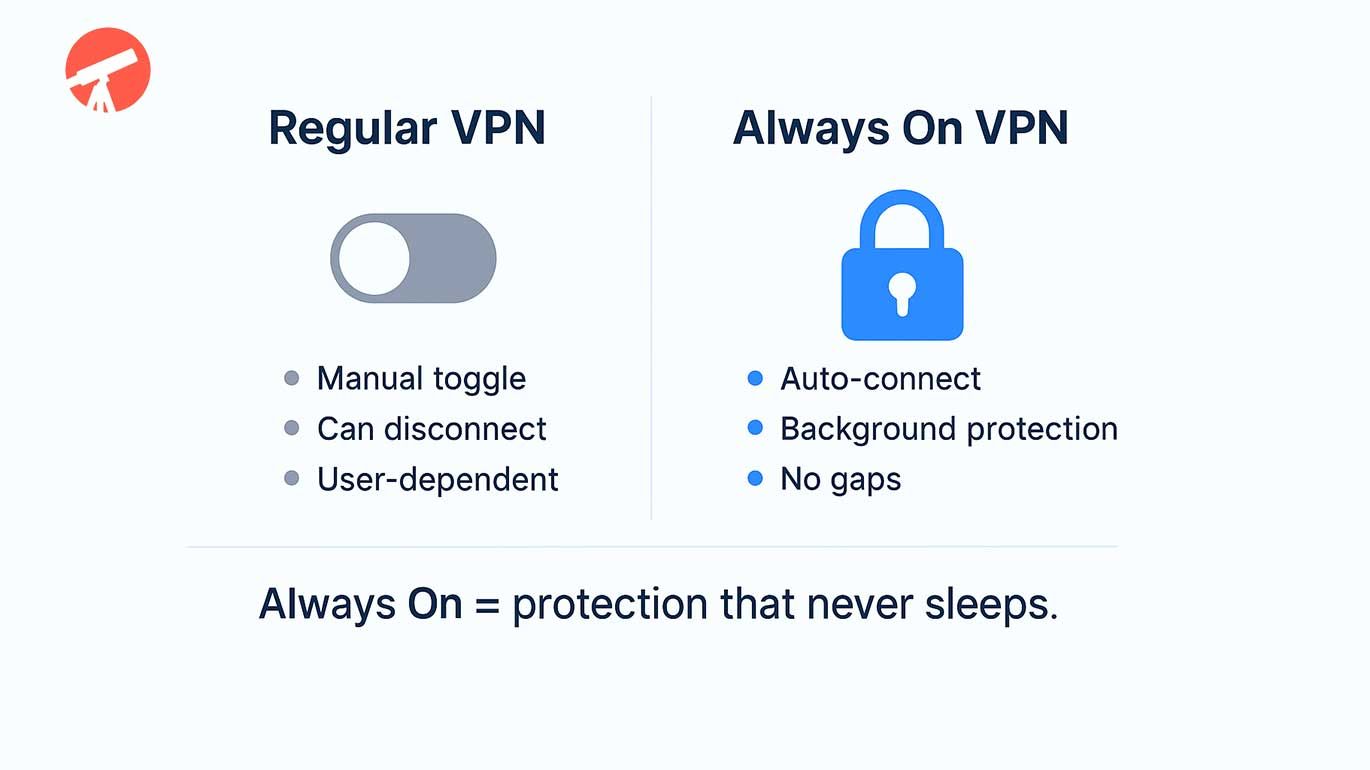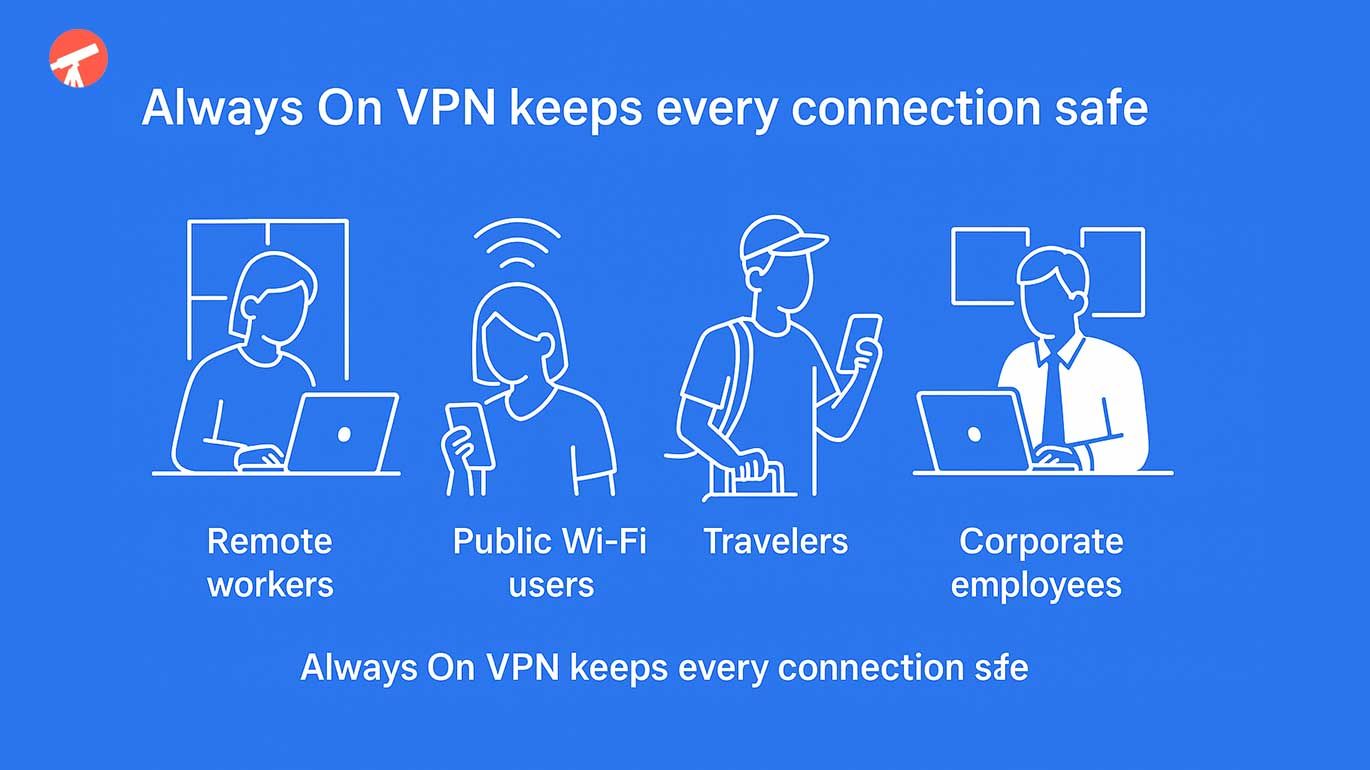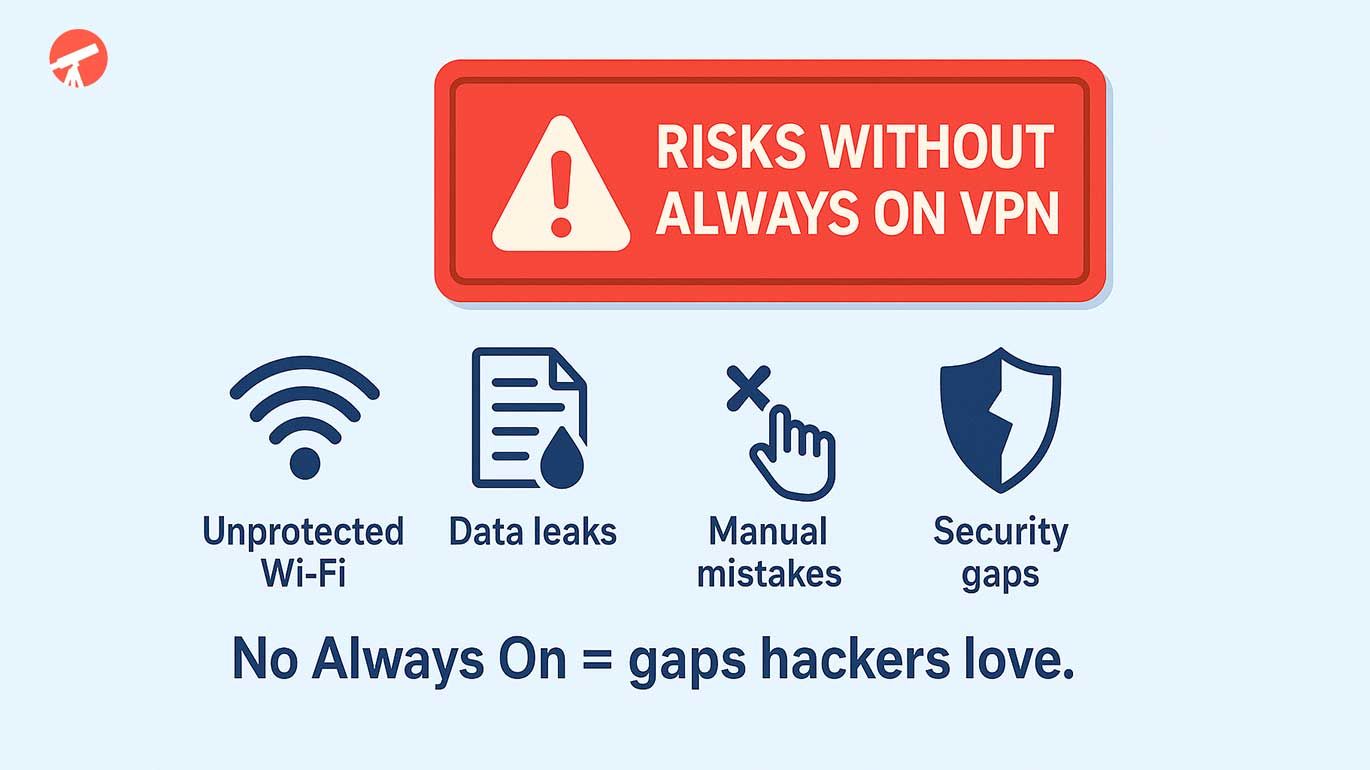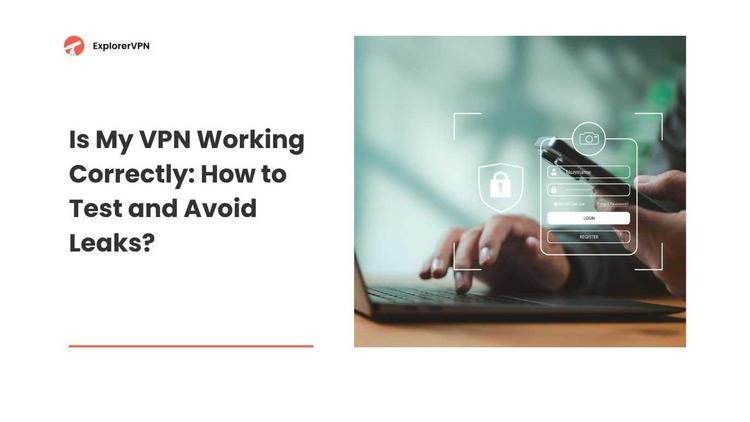An Always On VPN means the VPN never turns off by itself and stays connected all the time to protect your internet traffic.
Always on VPN is a special way to make sure your device never goes online without protection. It connects before you even log in, stays on in the background, and reconnects quickly if it drops. It helps people who work from home, remote employees, use public Wi-Fi, or need extra safety for their personal apps. It gives a smoother experience since you don’t have to keep asking if your VPN connection is working. It’s a little different from a normal VPN client, and it can be set up on Windows operating systems, Android, iOS, and other systems. But it also has some drawbacks, like being harder to set up at first.

Awlays on VPN benefits
What is an Always On VPN?
So, what is Always On VPN? It is a special kind of VPN access (virtual private network) that stays running all the time, not just when you remember to click it. A normal VPN is something you turn on when you want privacy or when you are on public Wi-Fi. But an Always On VPN is different. Once it is set up, it is Always On. The idea is that your device is never without secure access, which means all your data is encrypted before it goes across the internet. This kind of VPN is used a lot in schools, companies, and even on personal phones to maintain network security and securely access network resources.
How does an Always On VPN work?
An Always On VPN works in the background. When your device starts, the VPN starts too, even before you log in. The system makes sure your internet traffic always goes through the VPN tunnel. If the connection drops, it reconnects automatically. This means you are not left unprotected. Unlike a kill switch for VPN, which blocks traffic when the VPN drops, Always On VPN is more about staying connected so there are no gaps.
It does this by setting rules in your device system. For example, Windows Server and Android have settings for “VPN Always On.” iOS and macOS can use configuration profiles too. The rules tell the device to never allow traffic to go out unencrypted. So, even if you move from home Wi-Fi to your phone’s data, the VPN session stays active, using methods like machine certificate authentication, user certificates, or even multi factor authentication for enhanced security.
How to set up Always On VPN?
Setting up an Always On VPN depends on what device you have. On Windows computers, administrators often set it up with group policies, Server Manager, or PowerShell scripts. On Android, you can choose “Android Always On VPN” in the system VPN settings. On iPhones, there is a way to use profiles to keep VPN on all the time by checking the “connect on demand” feature.
For businesses, IT admins usually push settings to devices through mobile device management. On your own phone, you might just go into the VPN menu and pick the option to make it Always On. It might sound like a VPN basic at first, but once it is running, it feels automatic and simple, especially when tied into Active Directory Domain Services or Azure Conditional Access for corporate enforcement.

Who always on VPN keeps safe the most
What are the benefits of using the Always On?
Here’s the most important ones:
-
Peace of mind. You don’t have to remember to switch the VPN on. For example, if you sit down at a café and connect to public Wi-Fi, your VPN is already active. This makes it a strong VPN for safety, secure connection and communication, and protecting remote access connections.
-
Stronger protection for workers. People using laptops outside the office are still covered, even on risky networks. For companies, this also means simpler rules, administrators can enforce settings using a Network Policy Server (NPS server) or RADIUS authentication so everyone stays safe without having to double-check.
-
Smoother experience. Once it’s set up, the VPN works silently in the background. Users don’t have to wonder, “Did I connect?” It just happens, which makes things easier and less stressful.
-
More control in big organizations. Always-on VPN connectivity can handle different tunnels at different times. For example, device tunnels may connect before login, while user tunnels start after. This gives IT teams more flexibility to manage access securely and configure authentication methods based on industry standard configuration templates.

Risks without always on vpn
What type of security does Always On VPN provide?
Always-on VPN uses strong encryption to keep data safe, just like normal VPNs. But the difference is that it’s enforced. This means your information, like passwords or chat messages, doesn’t go out without protection. Whether you’re using VPN for WhatsApp, VPN for Telegram, or another platform, the traffic is always encrypted. That’s useful if you’re in places where these apps are blocked or spied on.
It also helps stop accidental leaks. For example, if the Wi-Fi resets or your laptop sleeps and wakes up, the VPN will reconnect using Internet Key Exchange Version 2 (IKEv2). So your device won’t accidentally send data without the tunnel. Combined with trusted network detection and modern authentication methods, this ensures a higher level of security.
How to deploy Always On VPN in your organisation?
In organizations, Always On for VPN users is usually deployed by IT teams. They may use device management tools to push the settings to every computer or phone. On Windows, it’s often configured with PowerShell scripts, Intune, or by integrating with Active Directory and Active Directory Certificate Services. On Android, admins can lock the Android Always On VPN connection setting so users can’t turn it off. On iPhones, profiles can set iOS Always On VPN to enforce the rule.
Admins can also configure authentication methods like machine or computer certificates via certificate templates, integrate with a domain controller, or use the Azure Conditional Access platform to create advanced scenarios for remote users.
Deployment usually happens in stages. First, IT sets up a test group, then expands to all users. This helps catch problems before everyone uses it, and ensures VPN authentication with DNS servers, network adapters, and load balancing is stable.
What's the difference between AOVPN and a traditional VPN?
A traditional VPN is something you launch when you want to. You open the app, press connect, and when you’re done, you disconnect. Always-on VPN, or AOVPN, doesn’t need that step. It runs automatically all the time.
Traditional VPNs are good for people who only want privacy sometimes, like when they travel. But AOVPN is better for people who always need protection, like workers with sensitive data who need to securely access the corporate network. The main difference is choice: a normal VPN is optional, but Always On VPN is enforced through policies like VPN conditional access.
Should you leave AOVPN on all the time for enhanced security?
Yes, that is the whole point of AOVPN. If you turn it off, it’s not really Always On anymore. Some people might wonder about VPN pros and cons. One con is that it can slow down internet speed a little. Another con is that it might use more battery on a phone. But the pro is that you get nonstop protection. So, if you are asking why the VPN is not connecting or worrying if you forgot to switch it on, you don’t have to anymore.
Are there any disadvantages of using Always On?
There are a few. First, setup is more complicated, often involving VPN infrastructure, VPN gateway, or network policy server console. You might need help from an IT admin. Second, if the VPN server is down, you might not have internet access at all. This can make people frustrated. Third, on some phones or laptops, battery or performance might be slightly worse. And sometimes, if the VPN configuration is wrong, it can cause apps not to work.
But compared to the safety it gives, many people think it is worth it.
How Always On VPN compares to Kill Switch?
Always On VPN and Kill Switch protect user traffic differently when a VPN connection drops. Kill Switch immediately blocks internet access to prevent unencrypted data leaks. Always On VPN automatically re-establishes the tunnel, keeping traffic encrypted and continuous.
Kill Switch stops all traffic during a connection loss, while Always On VPN minimizes downtime by maintaining constant activity. Kill Switch may require manual reconnection; Always On VPN reconnects without user action.
Kill Switch focuses on privacy during temporary network instability. Always On VPN ensures persistent protection for remote or mobile users who rely on uninterrupted security.
A Kill Switch can interrupt legitimate internet activity when a drop occurs. Always On VPN eliminates such interruptions but, if misconfigured, can cause short periods of no connectivity or fallback to an unsecured network.
In short, Kill Switch isolates, Always On VPN sustains.
Conclusion
Always-on VPN is a function which you don’t have to remember, it just works. It helps keep data safe on phones, tablets, and computers, whether you’re at home, school, work, or traveling. While it has some drawbacks, like setup difficulty and small slowdowns, the benefits are strong.


